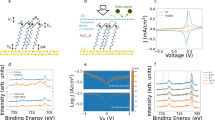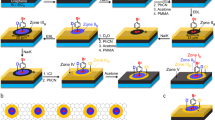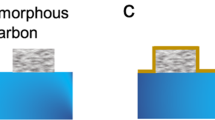Abstract
Encoding electronic functionality into nanoscale elements during chemical synthesis has been extensively explored over the past decade as the key to developing integrated nanosystems1 with functions defined by synthesis2,3,4,5,6. Graphene7,8,9,10,11,12 has been recently explored as a two-dimensional nanoscale material, and has demonstrated simple device functions based on conventional top-down fabrication13,14,15,16,17,18,19,20. However, the synthetic approach to encoding electronic functionality and thus enabling an entire integrated graphene electronics in a chemical synthesis had not previously been demonstrated. Here we report an unconventional approach for the synthesis of monolithically integrated electronic devices based on graphene and graphite. Spatial patterning of heterogeneous metal catalysts permits the selective growth of graphene and graphite, with a controlled number of graphene layers. Graphene transistor arrays with graphitic electrodes and interconnects were formed from the synthesis. These functional, all-carbon structures were transferable onto a variety of substrates. The integrated transistor arrays were used to demonstrate real-time, multiplexed chemical sensing and more significantly, multiple carbon layers of the graphene–graphite device components were vertically assembled to form a three-dimensional flexible structure which served as a top-gate transistor array. These results represent substantial progress towards encoding electronic functionality through chemical synthesis and suggest the future promise of one-step integration of graphene–graphite based electronics.
This is a preview of subscription content, access via your institution
Access options
Subscribe to this journal
Receive 12 print issues and online access
$259.00 per year
only $21.58 per issue
Buy this article
- Purchase on Springer Link
- Instant access to full article PDF
Prices may be subject to local taxes which are calculated during checkout




Similar content being viewed by others
References
Lu, W. & Lieber, C. M. Nanoelectronics from the bottom up. Nature Mater. 6, 841–850 (2007).
Dai, H. Carbon nanotubes: Synthesis, integration, and properties. Acc. Chem. Res. 35, 1035–1044 (2002).
Yang, C., Zhong, Z. & Lieber, C. M. Encoding electronic properties by synthesis of axial modulation-doped silicon nanowires. Science 310, 1304–1307 (2005).
Lauhon, L. J., Gudiksen, M. S., Wang, D. & Lieber, C. M. Epitaxial core–shell and core–multishell nanowire heterostructures. Nature 420, 57–61 (2002).
Kocabas, C., Shim, M. & Rogers, J. A. Spatially selective guided growth of high-coverage arrays and random networks of single-walled carbon nanotubes and their integration into electronic devices. J. Am. Chem. Soc. 128, 4540–4541 (2006).
Zhou, W., Ding, L., Yang, S. & Liu, J. Orthogonal orientation control of carbon nanotube growth. J. Am. Chem. Soc. 132, 336–341 (2010).
Novoselov, K. S. et al. Two-dimensional gas of massless Dirac fermions in graphene. Nature 438, 197–200 (2005).
Zhang, Y., Tan, Y., Stormer, H. L. & Kim, P. Experimental observation of the quantum Hall effect and Berry’s phase in graphene. Nature 438, 201–204 (2005).
Novoselov, K. S. et al. Electric field effect in atomically thin carbon films. Science 306, 666–669 (2004).
Lee, C., Wei, X., Kysar, J. W. & Hone, J. Measurement of the elastic properties and intrinsic strength of monolayer graphene. Science 321, 385–388 (2008).
Seol, J. H. et al. Two-dimensional phonon transport in supported graphene. Science 328, 213–216 (2010).
Nair, R. R. et al. Fine structure constant defines visual transparency of graphene. Science 320, 1308–1308 (2008).
Levendorf, M. P., Ruiz-Vargas, C. S., Garg, S. & Park, J. Transfer-free batch fabrication of single layer graphene transistors. Nano Lett. 9, 4479–4483 (2009).
Kim, K. S. et al. Large-scale pattern growth of graphene films for stretchable transparent electrodes. Nature 457, 706–710 (2009).
Jobst, J., Waldmann, D., Emtsev, K. V., Seyller, Th. & Weber, H. B. Transport properties of single-layer epitaxial graphene on 6H-SiC (0001). Mater. Sci. Forum 645–648, 637–641 (2010).
Mattevi, C., Kim, H. & Chhowalla, M. A review of chemical vapour deposition of graphene on copper. J. Mater. Chem. 21, 3324–3334 (2010).
Li, X. et al. Large-area synthesis of high-quality and uniform graphene films on copper foils. Science 324, 1312–1314 (2009).
Reina, A. et al. Large area, few-layer graphene films on arbitrary substrates by chemical vapor deposition. Nano Lett. 9, 30–35 (2009).
Jauregui, L. A., Cao, H., Wu, W., Yu, Q. & Chen, Y. P. Electronic properties of grains and grain boundaries in graphene grown by chemical vapor deposition. Solid State Commun. 151, 1100–1104 (2011).
Han, M. Y., Ozyilmaz, B., Zhang, Y. & Kim, P. Energy band-gap engineering of graphene nanoribbons. Phys. Rev. Lett. 98, 206805 (2007).
Li, X., Cai, W., Colombo, L. & Ruoff, R. S. Evolution of graphene growth on Ni and Cu by carbon isotope labeling. Nano Lett. 9, 4268–4272 (2009).
Blake, P. et al. Making graphene visible. Appl. Phys. Lett. 91, 063124 (2007).
Dresselhaus, M. S., Jorio, A., Hofmann, M., Dresselhaus, G. & Saito, R. Perspectives on carbon nanotubes and graphene Raman spectroscopy. Nano Lett. 10, 751–758 (2010).
Bae, S. et al. Roll-to-roll production of 30 inch graphene films for transparent electrodes. Nature Nanotech. 5, 574–578 (2010).
Bhaviripudi, S., Jia, X., Dresselhaus, M. S. & Kong, J. Role of kinetic factors in chemical vapor deposition synthesis of uniform large area graphene using copper catalyst. Nano Lett. 10, 4128–4133 (2010).
Zhang, Y., Small, J. P., Pontius, W. V. & Kim, P. Fabrication and electric-field-dependent transport measurements of mesoscopic graphite devices. Appl. Phys. Lett. 86, 073104 (2005).
Yazyev, O. V. & Louie, S. G. Electronic transport in polycrystalline graphene. Nature Mater. 9, 806–809 (2010).
Dean, C. R. et al. Boron nitride substrates for high-quality graphene electronics. Nature Nanotech. 5, 722–726 (2010).
Ohno, Y., Maehashi, K., Yamashiro, Y. & Matsumoto, K. Electrolyte-gated graphene field-effect transistors for detecting pH and protein adsorption. Nano Lett. 9, 3318–3322 (2009).
Cohen-Karni, T., Qing, Q., Li, Q., Fang, Y. & Lieber, C. M. Graphene and nanowire transistors for cellular interfaces and electrical recording. Nano Lett. 10, 1098–1102 (2010).
Acknowledgements
We thank L. Wang for assistance on electrical measurements, Y. K. Kim for TEM characterization, and J. Cahoon and Q. Qing for helpful discussions. J-U.P. thanks UNIST for support through the 2010 Research Fund, and S.N. thanks the Samsung Scholarship. This research was supported by a research project of National Research Foundation of Korea (Grant number: 20110014111), and by a NIH Director’s Pioneer Award (5DP1OD003900).
Author information
Authors and Affiliations
Contributions
J-U.P., S.N. and C.M.L. designed the experiments. J-U.P., S. N. and M-S. L. performed the experiments. J-U.P., S.N. and C.M.L. analysed the data and wrote the paper.
Corresponding authors
Ethics declarations
Competing interests
The authors declare no competing financial interests.
Supplementary information
Supplementary Information
Supplementary Information (PDF 1414 kb)
Rights and permissions
About this article
Cite this article
Park, JU., Nam, S., Lee, MS. et al. Synthesis of monolithic graphene–graphite integrated electronics. Nature Mater 11, 120–125 (2012). https://doi.org/10.1038/nmat3169
Received:
Accepted:
Published:
Issue Date:
DOI: https://doi.org/10.1038/nmat3169
This article is cited by
-
Micro- and nanofabrication of dynamic hydrogels with multichannel information
Nature Communications (2023)
-
Sensors for in situ monitoring of oral and dental health parameters in saliva
Clinical Oral Investigations (2023)
-
Carbon-based Multi-layered Films for Electronic Application: A Review
Journal of Electronic Materials (2021)
-
Complementary doping of van der Waals materials through controlled intercalation for monolithically integrated electronics
Nano Research (2020)
-
An integrated multi-layer 3D-fabrication of PDA/RGD coated graphene loaded PCL nanoscaffold for peripheral nerve restoration
Nature Communications (2018)



